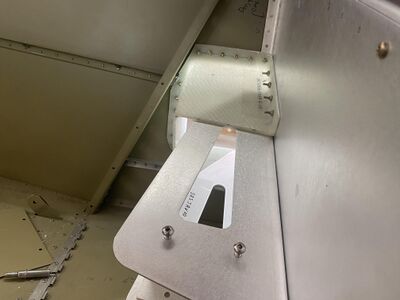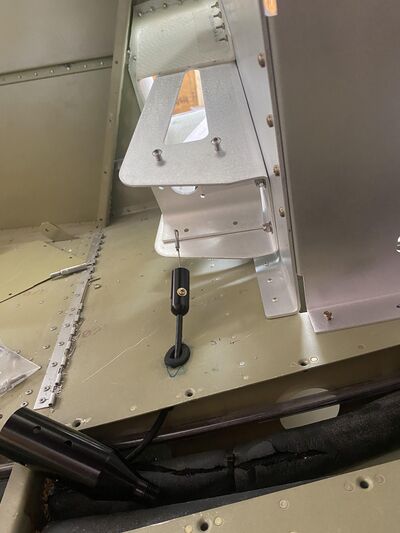BRS Installation Hints
Jump to navigation
Jump to search
Builder Logs
Additional Parts Needed
- Shrinker tool (for rear vertical angle bracket forming) at Spruce
- 5-10x 5/32 black clecos (for #8 screw holes, needed e.g. when match-drilling the floor holes into the new stringer) #20-103 at Pan American Tools
- 7/16 X 1/8 HSS REV SPOTFACER (for creating flat nut seats in uneven fiberglass through bore hole) #26-108 at Pan American Tools
1/8 ARBOR FOR REV SPOTFACER (for above tool) #27-102 at Pan American Tools - Tesa 4934 double sided tape with fabric backing, 25 mm wide on eBay
- 7 inch long angle bracket 3/4 x 3/4 x 1/16
- 3/32 or 1/8 hole finder for the side skin screw holes that hold the fiberglass rocket guide.
- #28 drill for the fiberglass holding screws
- additional MS24693-S30 6-32 3/4 long screws (McMaster 93085A151) and MS21045-06 6-32 locknuts with flange (McMaster 99638A102) for mounting the fiberglass rocket guide (the kit contains 21 but if you space the fasteners 1 inch apart, you need some 5 more, plus spares are good to have since they do break easily).
- Aluminum tape, e.g. Ace 47522
- Foam seal. The usual HomeDepot / ACE seals don't stick well enough, consider using the loop side of a Velcro tape, e.g. from Amazon.
- Adhesive for strap covers, see also this FB thread.
Top Rear Attachment Gussets
- If you position the gussets, check whether they potentially sit against clecos and aren't tucked in completely. If you install the parachute during the construction of the RV-10, the tailcone upper skin is still not riveted. Those rivets will sit against the outside of the bend in the upper gusset. Evaluate how much room will be needed for the dimples / shop heads.
- The manual asks for a 7.5 inch distance between the center of the gussets. Being that close is really not easily achievable and the photos in the manual don't comply.
- On the right side, the gusset needs to anyway sit further to the outside because of the vertical baggage bulkhead channel (F-1028). The gusset therefore overlaps the outside J-stiffener (F-1047) and you actually need to maximize the overlap to have proper edge distance for the rivet holes that go through the gusset. It also requires to make the gusset thinner where the stiffener overlaps. The overlap can easily be marked after match drilling and bolt installment if the top skin is taken off. The rivet holes in the gusset need to be counter sunk as the stiffener is dimpled.
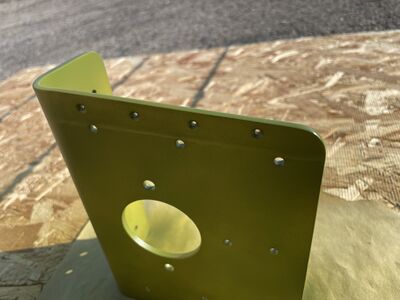
- If you locate the left angle bracket 7.5 inches center to center apart from the right one, the bracket overlaps the center J-stiffener at a slanted angle which doesn't work as some rivet holes will have bad edge distances. A compromise is to overlap the center stiffener just a tiny bit at the front. The center to center distance is then 8 5/8 inches. The gusset needs to be thinned to accommodate the short stiffener overlap.
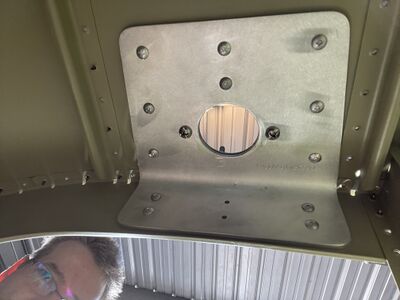
Picture shows temporary fasteners installed inside out for convenience. Gusset isn't primed yet. Ignore the bottom row of holes that are match drilled into the bulkhead. It is better to match drill the holes of the corrugated bulkhead into the bulkhead and the gusset later when closing out the tailcone.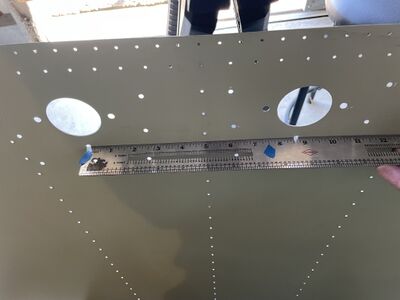
- The fastener holes need a #19 drill.
- The two larger 1/4 inch holes that need to be match drilled should be pre-drilled with a smaller diameter drill bit first using the 1/4 to 1/8 inch bushing which comes with the RV-10 kit.
- The big round hole of the angle bracket that needs to be match-drilled into the top skin has the size of a 1.5 inch conduit (actual hole size: 1.951 inches). Very easy to do with a hydraulic punch, e.g. at Amazon. Suitable should also be a bare punch set that uses a bolt instead of hydraulics, e.g. at Amazon.
- If you also have an Airflow AC together with an Aerosport overhead console, several things need to be taken into account:
- You can't feed the air through the bulkhead as the gusset is in the way. Consider using two 2 inch flanges (Spruce Part# 10350-8) for the overhead console and two flange ducts (Spruce Part# 08-04140) for the bulkhead to route the air in from the bottom.
- Consider trimming the overhead console by 1/8 inch at the end and capping it with a fiberglass sheet. This way, the end of the overhead console doesn't need to be air tight where it interfaces with the bulkhead.
- There is a certain order of assembly to make things work:
- final mount the canopy
- final mount (rivet) the center section (from the middle to the two outer stiffeners) of the top skin that attaches to the canopy. Use fuel tank sealant just in this center section.
- final mount the gussets. Use plenty of epoxy with flox to bridge the air gap between the gusset and the top skin.
- final mount (bond) the overhead console to the canopy
Bottom Rear Attachment Bracket
- The manual says to avoid interference with the longitudinal stringers however, the brackets don't fit between them. The photos also show overlap. One needs to grind away a bit to allow space for the stringer.
- Note: the manual has photos of a different bottom rear attachment bracket. It has a square profile (which means it interferes with the shop heads). The current kit comes with a bent bottom bracket which leaves room for the shop heads but the holes moved higher up and now don't fit below the lighting hole.
- The distance of the centers of the brackets should be 15 inches. However that is not achievable. The center tunnel is 2.4 inches outside to outside wall. The bracket is 4.8 inches wide, so the gap between bracket and center tunnel should be 3.9 inches to give you 15 inches center to center (2.4 + 3.9 + 2.4 + 3.9 + 2.4). If you do that you are crossing the stiffener in the middle of the bracket. Doable is 0.5 inch which gives you 8.2 inches center distance (2.4 + 0.5 + 2.4 + 0.5 + 2.4). This is also what the photo shows in violation with the instructions. Best is to align the innermost hole with the rivet line that connects the F-1019-L inboard baggage rib with the F-1006B Bulkhead.
- The edge distance for the holes in the area of the lighting hole of the bulkhead is violated if used as shipped in the kit. One needs to move the outer bolt lower (a tiny bit into the bend; the bend needs to be ground flat for the screw head) and the 2nd outermost hole towards the center.
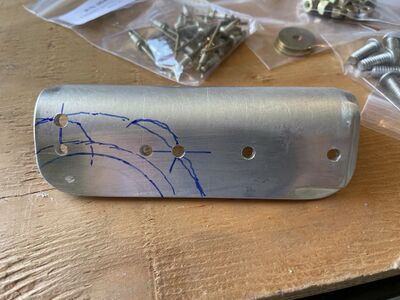
The lines represent the lighting hole inside diameter, the lighting hole diameter where it starts being flat and then 2xD edge distance to all edges.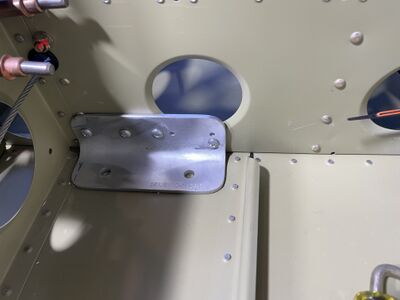
Note:Fasteners shown are temporary in all images. Brackets aren't primed yet.
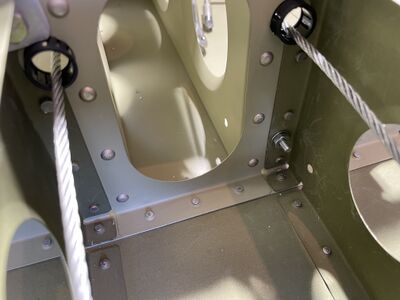
- On the inside top corner, the bracket interferes with a rivet in the bulkhead, one needs to make an indent.
- The 5/16 hole match drilling can be done using a 5/16 to 1/4 inch drill bushing or a short piece of aluminum tube with 5/16 OD and 1/4 ID. With it, drill a 1/4 inch hole from the inside to the outside using an angle drill attachment. Then use a unibit step drill and widen the hole from the underside of the fuselage from 1/4 to 5/16. Finally file a bit from the inside to ensure the hole matches all the way around the circumference.
Rear Attachment External Plate
- Mark the centerline on the underside of the bottom skin. Mark the centerline on the external plate. Assess the fit and bend the plate until it conforms to the shape of the tailcone.
- Bend the external plate in both directions until if follows the contour of the bottom fuselage skin and the edges sit tight against the skin.
- Use duct tape to tape the bottom plate to the bottom skin.
- Match drill one of the 5/16 hole using a drill bushing and step drill bit as before and fasten the bottom plate using a bolt and nut.
- The manual doesn't specify where exactly to place the roughly 30 3/32 rivets. If you haven't left the rivets open during the tailcone build and tailcone attachment, one option is to drill out existing rivets, another is to make new holes in between existing rivets, slightly out of line but still keeping 3/16 stiffener edge distance. The minimum distance between rivets in a double row is 4 x diameter (3/8 for 3/32 rivets), see AC 43.13-1B, page 4-20. As the regular rivets are more than 1 inch apart, it isn't a problem to add another rivet at mid distance.
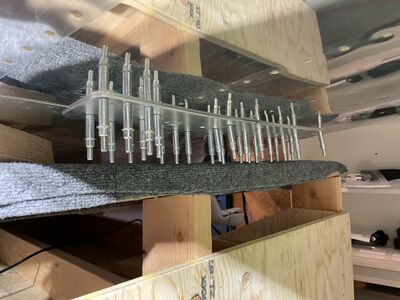
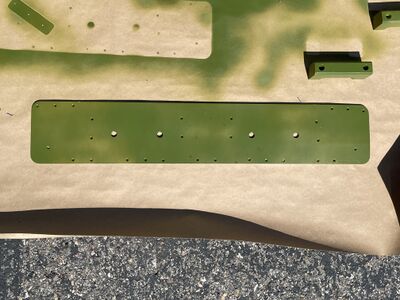
- Holes that don't have a flange as a natural doubler need a doubler where the skin is a single layer
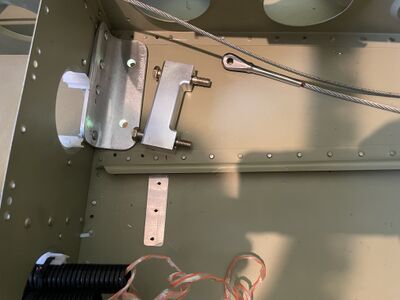
- Primed and assembled rear bottom attachments. The bottom washers are the larger ones (the manual doesn't spell out large washers).
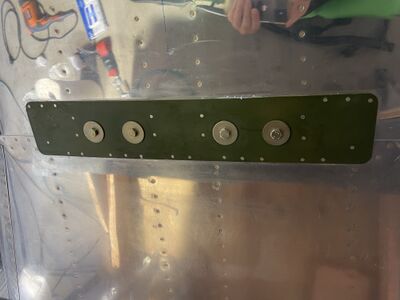
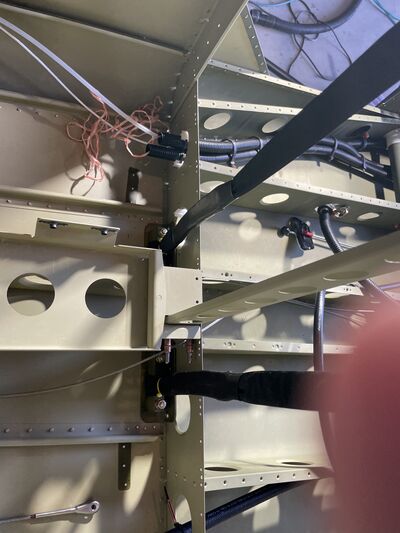
- If you have the Airflow AC, the straps can be routed around the air inlets.
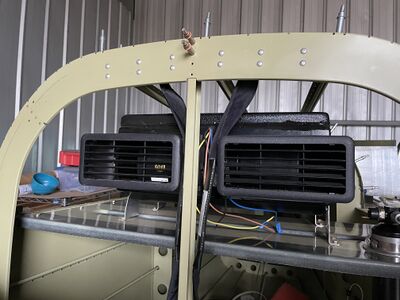
Parachute Canister
- The canister parts need to be thoroughly deburred and the 90 degree corners need to be rounded with a file. The edges of the 8 slots where the parachute straps go through to hold the bag back need to be rounded off.
- The manual states to remove the top lid of the canister and then mark the cut-outs. However, if you do that the side walls (especially the rear one) have no guidance and the cut-out will not be accurate. Consider marking the outside of the canister in the fully assembled state and then do corrections based on measurements or re-alignment with the previous marks. The same goes for match-drilling the rear angle bracket. Better to assemble the entire canister whenever working on the boundary canister - fuselage side skin.
- The manual states to use a stretcher machine to bend the rear angle so it matches the fuselage skin, however one needs to shrink the angle flange. Anyway, if you overdo the shrinking, you need a stretching function for correction, so maybe get the combo shrinker / stretcher anyway.
- The pre-drilled holes in the rear angle bracket that will be match-drilled into the outer skin may not be properly aligned with the edge of the bracket, so don't use the line of holes as a reference for the cut-out.
- Don't use the pre-drilled outermost hole on the front (rocket) side. It is too close to an existing hole and the rib. Move the hole accordingly to not hit the underlying rib and one of its rivets.
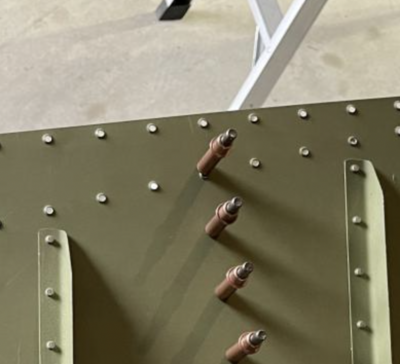
- Watch out for the inboard flange of the canister. It's not possible to position the box avoiding having to drill into the radius of the tunnel rib. Consider relocating one of the screw holes and omitting the furthest aft hole.
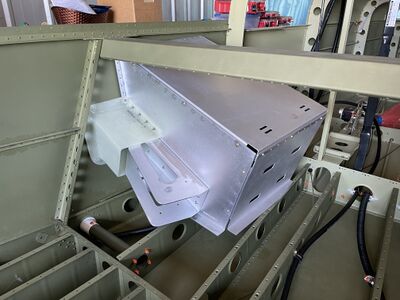
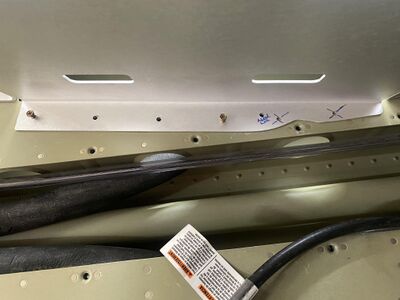
- Trim the inside canister flange along the tunnel cover to allow mounting it without interference.
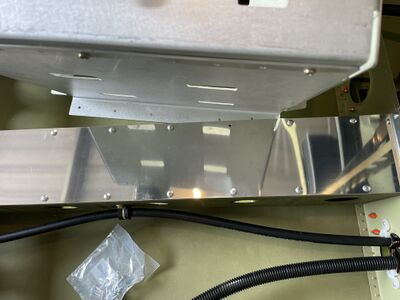
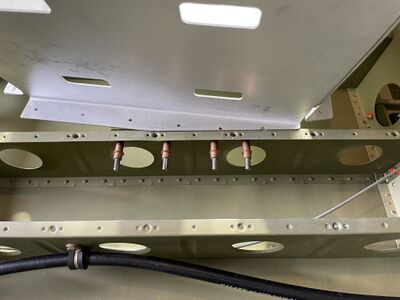
- Consider adding a 7 inch long angle bracket to the baggage floor rib to provide good support for 3 newly located rear flange holes (picture has one hole with edge distance issues, move it more towards the rib).
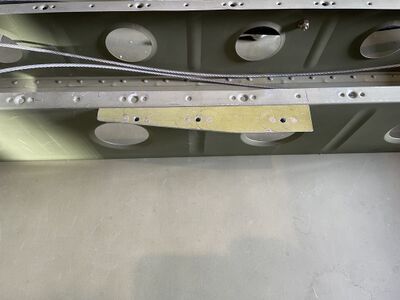
- Easiest way to do the cut-outs is to do a rough cut using a nibbler or saw, then do a precise cut to the line using aviation snips.
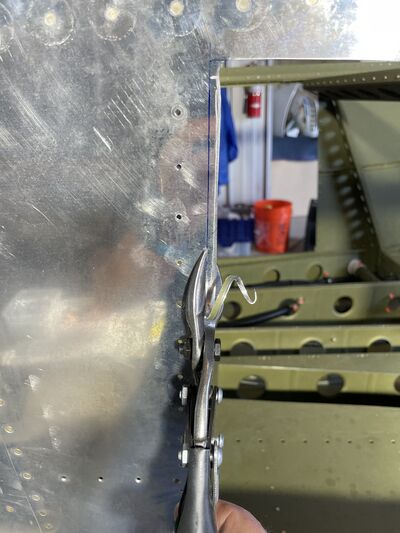
- After cutting out the luggage floor rectangle, consider removing the short remnants of the stiffeners that are each held by just one rivet (already removed at the bottom of this image). Round off the two remaining stiffeners towards the cut-out.
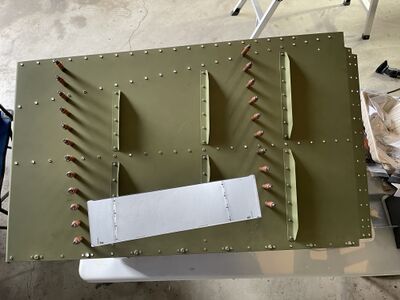
Rocket Support
Rocket Activation Handle
- Handle installation for planes with the Aerosport console.
The housing that the handle is in is larger than the Aerosport surface, so one has to cut the side of the panel.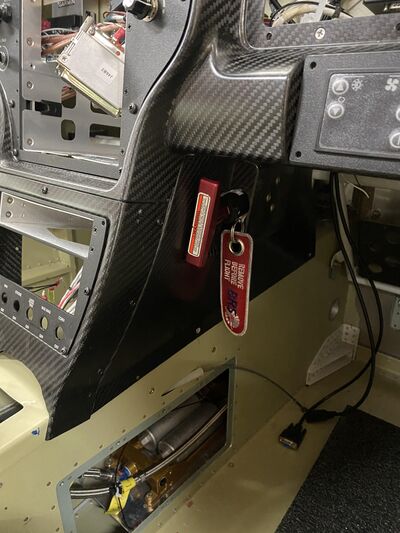
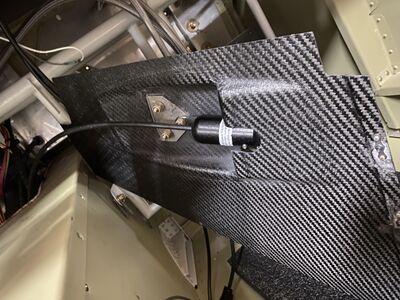
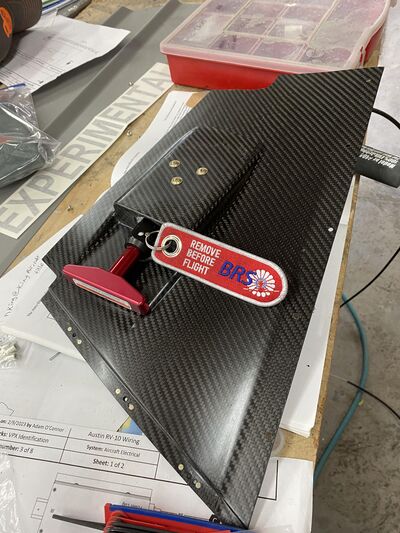
Parachute Installation
- The parachute needs to be installed into the canister/airplane right when it arrives from shipping. Else the parachute will reshape from a cube into a sphere and it won't easily fit. Even when you install it right away, the sides are bulged out but pushed back as you tighten the screws. It helps to have a large clamp that pushes the two side panels in while you get the screws threaded.
- The shackles are attached to the bag with a strap that has white stitching. When the bag arrives, those straps run through the shackles centered. This will make the shackles sit too high on hard ridges towards the edge. The lid will not close down. If you push the shackles towards the center, with the strap now running off center, the shackles will sit down since they are off the hard ridge.

